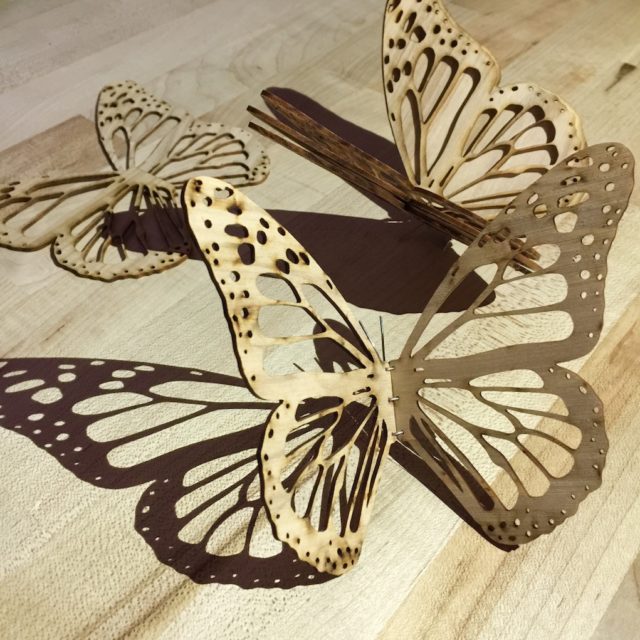
There is an unmistakeable sound of a woodshop — of the lathes, routers and lasers cutting, etching, carving — all absorbed and echoed in the resounding wood.
Inside BLDG 61, the Makerspace at the Boulder Public Library, the woodshop is humming. Six months after the space opened, a group of eight apprentices are there to learn the basics of the craft.
A month into the three-month program, the participants are already familiar with the materials and the first flashes of inspiration are striking. They are beginning to imagine all the potential for creation in their new medium.
One woman, Dana, shares an idea she has for the wood she holds in her hand: to transform the block into a butterfly.
The idea catches on and soon the apprentices are carving dozens of blocks into butterflies as if to enact the metamorphosis the insect symbolizes.
For Dana, it represents the transformation into sobriety. For others, from homelessness to housing, from unemployment to skilled woodworker. And still there is another story, the journey of the wood itself, once a living ash tree, now art.
Each of these stories is an equally important part of #TreeOpp, a program that trains homeless clients of Bridge House’s Ready to Work Program to make furniture and art from trees felled as a result of the invasive emerald ash borer (EAB).
EAB first came to Boulder in September 2013 signaling the inevitable demise of the city’s entire population of ash trees. An exotic beetle, EAB is native to Asia and is thought to have been carried to the United States in wood packaging aboard cargo ships. The adult beetles nibble on ash foliage causing little damage, but the larvae live and feed on the inner bark of the trees, causing irreparable harm to the tree’s circulatory systems.
There are approximately 6,000 ash trees on public land in the City of Boulder and 78,000 on private land. In the next two months alone, the City will take down about 200 trees, which are then transported to a lot where, restricted by the quarantine on EAB-infested wood, they await either a landfill or incinerator.
EAB is confirmed to exist in 28 states and communities across the country are wondering what to do with all that wood. Some have milling and lumber industries that can accommodate the extra biomass, but many, like Boulder, do not.
A little over a year ago, Yvette Bowden, director of Boulder City Parks and Recreation, looked out upon the growing pile of tree debris and came up with the idea for #TreeOpp.
“Instead of thinking about getting rid of it, we started thinking about how to use it,” Bowden says. “The concept of this program is to turn challenge into opportunity, not only to educate the public about EAB and wood utilization, but to give a new job skill in the process.
“We saw that we had a group of people looking to get back into the workforce, a space that is conducive to this kind of learning and a need for skilled artisans to process the wood into something useful or creative. In this way we give the tree a full life cycle.”
#TreeOpp received startup funding from the Knight Cities Challenge, a grant of the Knight Foundation. The challenge is held in 26 communities around the U.S. that were once home to newspapers owned by John S. and James L. Knight. Their media company Knight Ridder, Inc. owned the Boulder Daily Camera from 1969-1997.
While they were in the newspaper business, the brothers sought to create informed and engaged communities through journalism. Now their legacy continues with their foundation funding projects in the arts, journalism, technology and community development.
“We think that art is a very strong route towards engagement, to tell stories of the people in a community and to form a stronger attachment to place,” says George Abbott, from the community and national initiatives program at the Knight Foundation. “In turn they will be more inclined to seek out the information about where they live. In some ways the engagement is like the demand side of the equation, and journalism and information is the supply. We are trying to strengthen both to strengthen communities.”
#TreeOpp has a lot of potential to make progress in an array of social and environmental issues, but that isn’t the focus of the program just yet. For now, the organizers are enjoying watching the “experiment” as it unfolds and are excited about what can happen as #TreeOpp brings previously disparate groups together.
“It’s just a first step,” says Margo Josephs, manager of the program, “a way to get people to think about how to be responsible and thoughtful. …
“The fact that we can all come together and be creative and artful, to get out of the mindset of solving problems like homelessness or emerald ash borer and instead to think about how we can improve our community through creating.”
Back inside the woodshop in BLDG 61, the machines are abuzz with creation as wood chips fly off blocks of wood — the metamorphosis of the emerald ash borer into a butterfly.














